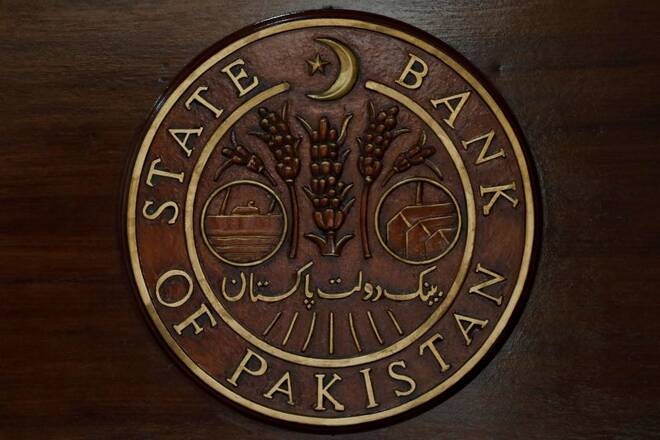Advertisement
Advertisement
Pakistan keeps policy rate at 15%, projects high inflation, weak growth
By:
By Syed Raza Hassan KARACHI, Pakistan (Reuters) - Pakistan's central bank kept its key policy rate unchanged at 15% on Monday, days after the South Asian country's credit rating was downgraded in the face of an economic meltdown exacerbated by devastating floods.
By Syed Raza Hassan
KARACHI, Pakistan (Reuters) – Pakistan’s central bank kept its key policy rate unchanged at 15% on Monday, days after the South Asian country’s credit rating was downgraded in the face of an economic meltdown exacerbated by devastating floods.
Pakistan is in the middle of a balance of payment crisis, with foreign reserves falling to barely one month’s worth of imports, a situation which has been aggravated by a devalued currency and consumer prices rising 27%.
Moody’s cut Pakistan’s sovereign credit rating on Thursday by one notch to Caa1 from B3, citing increased government liquidity and external vulnerability risks.
“Based on currently available information, the MPC (Monetary Policy Committee) was of the view that the existing monetary policy stance strikes an appropriate balance between managing inflation and maintaining growth in the wake of the floods,” the central bank said in a statement.
It said inflation could go higher and that growth prospects had weakened.
This was the central bank’s first policy decision since floods this summer killed more than 1,700 and caused an estimated $30 billion in damage.
GDP growth could fall to around 2% in the 2023 financial year compared to previous forecast of 3%-4% before the floods, the central bank statement said.
The initial budgetary estimate for the FY2023 ending in June was growth of 5%, which the World Bank has also said was now expected to be around 2%.
Pakistan’s economy grew more than expected in the last financial year, at 6%.
However, the central bank later said the economy faces significant imbalances including a large current account deficit and persistently high inflation.
The downgraded in Pakistan’s credit rating raised concerns that the country could default on its sovereign debt commitments after Prime Minister Shehbaz Sharif sought loan relief from Paris Club last month.
Finance Minister Ishaq Dar on Sunday said there will be no request for debt restructuring and Pakistan will honour all commitments.
Inflation vs policy rate
The central bank projected inflation after the floods to be on higher side compared to the last estimate of between 18%-20% in FY2022-23.
With prices of consumer goods rising over 25% in the first quarter of 2022-23, real interest rates remain deep in negative territory.
Higher food prices could raise average headline inflation, the bank said, adding that the impact on the current account deficit was likely to be muted.
It said it will leave the current account deficit in the vicinity of the previously forecast 3% of GDP.
Before May, when annual inflation breached 21%, the State Bank of Pakistan sought to keep real interest rates slightly positive. It has raised the official rate by 800 points since September 2021.
Imports hit a record high and surpassed export growth, sending Pakistan’s current account deficit to over $17 billion – close to 5% of GDP and six times higher than 2020-21 – propelled mainly by higher energy bills.
Efforts to cool an overheating economy, contain the current account deficit and introduce economic reforms have been welcomed by the International Monetary Fund (IMF), which has set such changes as preconditions for a financial bailout.
(Reporting by Syed Raza Hasan; Writing by Gibran Peshimam and by Asif Shahzad; Editing by David Goodman, Toby Chopra and Nick Macfie)
About the Author
Reuterscontributor
Reuters, the news and media division of Thomson Reuters, is the world’s largest international multimedia news provider reaching more than one billion people every day. Reuters provides trusted business, financial, national, and international news to professionals via Thomson Reuters desktops, the world's media organizations, and directly to consumers at Reuters.com and via Reuters TV. Learn more about Thomson Reuters products:
Advertisement
